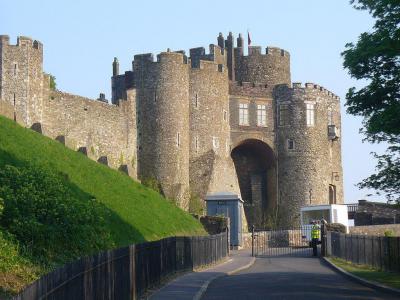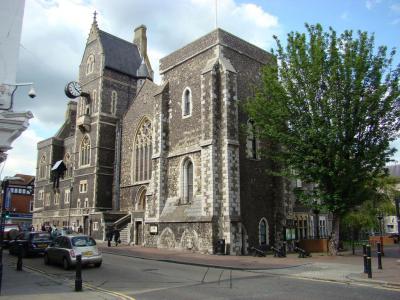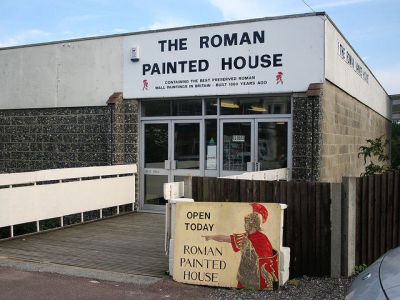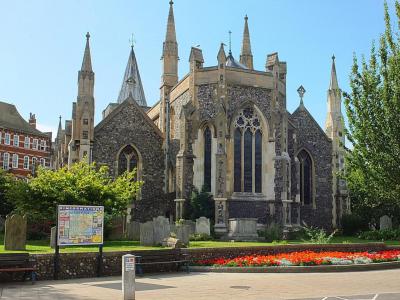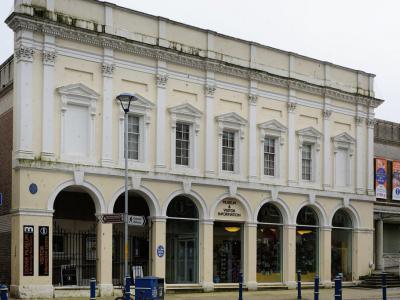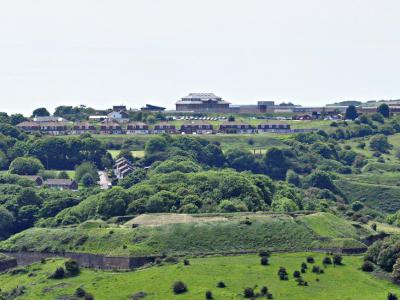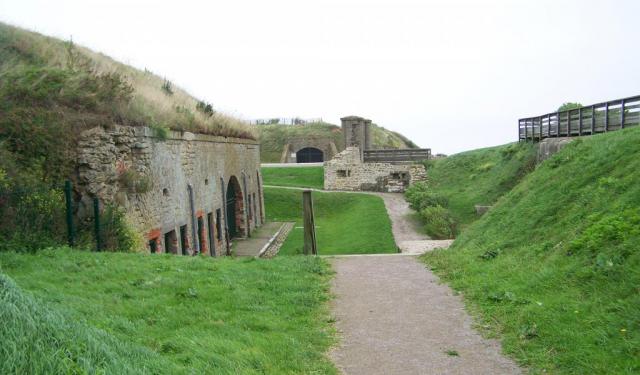Dover Introduction Walking Tour (Self Guided), Dover
The lovely coastal town of Dover in Kent, England, overlooking the English Channel from the height of the striking white chalk cliffs, has long been a major sea gate to the country. It is to this iconic landmark, known as the "White Cliffs of Dover", that the isle of Great Britain owes its nickname, the Albion.
According to archaeological findings, this location at the narrowest crossing point between England and continental Europe – the Strait of Dover – has been the point of travel and trade across the Channel since as early as the Bronze Age, if not earlier.
A pre-Roman settlement existed on the site and was first recorded as the fortified port, Portus Dubris, after the Roman conquest. Its name is derived from the Brythonic word for water, which also correlates with the name of the river, Dour, which runs through the city. During the Roman period, the area became part of the Roman communications network and was connected by road to Canterbury and Watling Street. There are several historical sites in Dover dating back to that period, including the Roman Painted House.
In the 4th century AD, it was guarded by a fort as part of the defenses of the Saxon Shore. During the 11th century, it was made one of the Cinque Ports.
The magnificent Dover Castle, built atop the cliffs, some 375 feet (114 metres) above sea level, dominates the landscape. On a clear day, the coast of France can be seen from there easily. Built to repel invasions from the sea, during WWII this medieval fortress – one of the largest in England – also served a defensive purpose, housing the extensive Secret Wartime Tunnels. Within its 80 acres there are also a Roman lighthouse, the ancient Church of St. Mary in Castro, the remains of the Saxon stronghold, and the massive Norman keep.
During WWII, Dover was heavily shelled from Nazi-occupied France and bombed from the air. The shattered seafront was subsequently redeveloped after the war, seeing Dover become a principal cross-Channel passenger ferry port in the United Kingdom.
A fascinating place to visit on your tour of Dover is the Dover Museum on Market Square, holding a collection of rare artifacts such as the ruins of a wooden boat aged circa 3,500 years. A walk around Dover Western Heights is yet another must-do experience for your Dover tour.
To explore the picturesque town of Dover in more detail, visiting these and other notable sites, take this self-guided walking tour.
According to archaeological findings, this location at the narrowest crossing point between England and continental Europe – the Strait of Dover – has been the point of travel and trade across the Channel since as early as the Bronze Age, if not earlier.
A pre-Roman settlement existed on the site and was first recorded as the fortified port, Portus Dubris, after the Roman conquest. Its name is derived from the Brythonic word for water, which also correlates with the name of the river, Dour, which runs through the city. During the Roman period, the area became part of the Roman communications network and was connected by road to Canterbury and Watling Street. There are several historical sites in Dover dating back to that period, including the Roman Painted House.
In the 4th century AD, it was guarded by a fort as part of the defenses of the Saxon Shore. During the 11th century, it was made one of the Cinque Ports.
The magnificent Dover Castle, built atop the cliffs, some 375 feet (114 metres) above sea level, dominates the landscape. On a clear day, the coast of France can be seen from there easily. Built to repel invasions from the sea, during WWII this medieval fortress – one of the largest in England – also served a defensive purpose, housing the extensive Secret Wartime Tunnels. Within its 80 acres there are also a Roman lighthouse, the ancient Church of St. Mary in Castro, the remains of the Saxon stronghold, and the massive Norman keep.
During WWII, Dover was heavily shelled from Nazi-occupied France and bombed from the air. The shattered seafront was subsequently redeveloped after the war, seeing Dover become a principal cross-Channel passenger ferry port in the United Kingdom.
A fascinating place to visit on your tour of Dover is the Dover Museum on Market Square, holding a collection of rare artifacts such as the ruins of a wooden boat aged circa 3,500 years. A walk around Dover Western Heights is yet another must-do experience for your Dover tour.
To explore the picturesque town of Dover in more detail, visiting these and other notable sites, take this self-guided walking tour.
How it works: Download the app "GPSmyCity: Walks in 1K+ Cities" from Apple App Store or Google Play Store to your mobile phone or tablet. The app turns your mobile device into a personal tour guide and its built-in GPS navigation functions guide you from one tour stop to next. The app works offline, so no data plan is needed when traveling abroad.
Dover Introduction Walking Tour Map
Guide Name: Dover Introduction Walking Tour
Guide Location: England » Dover (See other walking tours in Dover)
Guide Type: Self-guided Walking Tour (Sightseeing)
# of Attractions: 6
Tour Duration: 1 Hour(s)
Travel Distance: 2.8 Km or 1.7 Miles
Author: jenny
Sight(s) Featured in This Guide:
Guide Location: England » Dover (See other walking tours in Dover)
Guide Type: Self-guided Walking Tour (Sightseeing)
# of Attractions: 6
Tour Duration: 1 Hour(s)
Travel Distance: 2.8 Km or 1.7 Miles
Author: jenny
Sight(s) Featured in This Guide:
- Dover Castle
- Maison Dieu and Dover Town Hall
- The Roman Painted House
- St. Mary's Church
- Dover Museum
- Dover Western Heights
1) Dover Castle (must see)
Dover Castle is a stunning medieval castle that stands upon Castle Hill above the famous White Cliffs of Dover. Building began on this fortress-like castle during the 11th century. Dover Castle has often been called the "Key to England" because of its strategic position at the shortest crossing between continental Europe and England.
This grand hilltop structure features high walls and stately towers. Dover Castle is one of the largest castles in England, and there is plenty to see. The lavish interior of the Great Tower features decorations that recreate the regal rooms of a medieval castle. A feast for the eyes with magnificent furnishings, colorful tapestries, and over 500 objects. Costumed characters perform on selected days.
Beneath the castle is a network of medieval tunnels constructed for defensive purposes. These winding passageways are open for visitors to explore. Tours are available to discover the secret wartime tunnels of Dover Castle, used during World War II. An exhibition brings the history of the Dunkirk evacuation to life as you learn about the story of tunnels.
There are 80 acres of grounds around the castle, a great place to explore. An octagonal-shaped Roman lighthouse is an impressive structure built in the early 2nd century. It is one of only a few lighthouses in the world that has survived from the time of the Roman empire. This lighthouse later served as the bell tower at Saint Mary in Castro, a church on the Dover Castle grounds built around AD 1000. Still a working church, there are worship services each Sunday.
If you're hungry, you'll find a restaurant, a cafe, a tearoom, and a picnic area at Dover Castle. There is also a museum and two shops. Climb up to the roof of the Grand Tower for some magnificent views.
This grand hilltop structure features high walls and stately towers. Dover Castle is one of the largest castles in England, and there is plenty to see. The lavish interior of the Great Tower features decorations that recreate the regal rooms of a medieval castle. A feast for the eyes with magnificent furnishings, colorful tapestries, and over 500 objects. Costumed characters perform on selected days.
Beneath the castle is a network of medieval tunnels constructed for defensive purposes. These winding passageways are open for visitors to explore. Tours are available to discover the secret wartime tunnels of Dover Castle, used during World War II. An exhibition brings the history of the Dunkirk evacuation to life as you learn about the story of tunnels.
There are 80 acres of grounds around the castle, a great place to explore. An octagonal-shaped Roman lighthouse is an impressive structure built in the early 2nd century. It is one of only a few lighthouses in the world that has survived from the time of the Roman empire. This lighthouse later served as the bell tower at Saint Mary in Castro, a church on the Dover Castle grounds built around AD 1000. Still a working church, there are worship services each Sunday.
If you're hungry, you'll find a restaurant, a cafe, a tearoom, and a picnic area at Dover Castle. There is also a museum and two shops. Climb up to the roof of the Grand Tower for some magnificent views.
2) Maison Dieu and Dover Town Hall
The Maison Dieu (House of God in French) is an impressive medieval building founded in 1203. It was originally a rest stop and hospital for pilgrims making their way to the shrine of Thomas Becket in Canterbury. It also accommodated wounded and impoverished soldiers.
A chapel and the magnificent space known as Stone Hall were new additions during the 13th century. Stone Hall features a towering ceiling and stunning stained glass windows. Lining the walls of this grand old hall are portraits of dignitaries from Dover's past. There are also flags of the Cinque Ports, the five major ports of southeastern England.
Extensive restorations took place during the 19th century, and a Council Chamber was added to the end of Stone Hall. The addition of the Mayor's Parlour took place in the 1880s. It was a place for the mayor of Dover to hold meetings. Connaught Hall was also built at this time, a grand assembly room used for concerts, dances, and other public events.
In the 1830s, Maison Dieu was incorporated into the town hall. Dover Town Hall currently serves as a function hall, offering a historical setting for meetings, performances, special events, and weddings. Several of the building's beautiful rooms are available for hire by the public.
A chapel and the magnificent space known as Stone Hall were new additions during the 13th century. Stone Hall features a towering ceiling and stunning stained glass windows. Lining the walls of this grand old hall are portraits of dignitaries from Dover's past. There are also flags of the Cinque Ports, the five major ports of southeastern England.
Extensive restorations took place during the 19th century, and a Council Chamber was added to the end of Stone Hall. The addition of the Mayor's Parlour took place in the 1880s. It was a place for the mayor of Dover to hold meetings. Connaught Hall was also built at this time, a grand assembly room used for concerts, dances, and other public events.
In the 1830s, Maison Dieu was incorporated into the town hall. Dover Town Hall currently serves as a function hall, offering a historical setting for meetings, performances, special events, and weddings. Several of the building's beautiful rooms are available for hire by the public.
3) The Roman Painted House
The Roman Painted House was built around AD 200 and was part of a hotel for travelers crossing the English Channel. The ruins of this remarkable Roman House were excavated in the 1970s. The house was constructed out of brick and flint. The deteriorated walls of four rooms survive and stand between four to six feet in height.
Inside are magnificent Roman murals considered some of the best preserved in Great Britain. These unique wall paintings show scenes with Bacchus, the god of wine, vegetation, and fertility. The house includes a complete Roman heating system under the floor.
The ruins of the Roman Painted House are surrounded by an outer building. Visitors can view the remains of the house from the vantage point of an upstairs railed landing. The museum includes display cases filled with artifacts. There is also a table with items you can touch, including pottery, Roman tiles, and even animal bones. Don't miss the medieval skeleton on display! The house is open to the public seasonally.
Inside are magnificent Roman murals considered some of the best preserved in Great Britain. These unique wall paintings show scenes with Bacchus, the god of wine, vegetation, and fertility. The house includes a complete Roman heating system under the floor.
The ruins of the Roman Painted House are surrounded by an outer building. Visitors can view the remains of the house from the vantage point of an upstairs railed landing. The museum includes display cases filled with artifacts. There is also a table with items you can touch, including pottery, Roman tiles, and even animal bones. Don't miss the medieval skeleton on display! The house is open to the public seasonally.
4) St. Mary's Church
Saint Mary's Church is a lovely parish church located on Cannon Street in Dover's town center. This ancient structure is Norman in origin, built between 1066 and 1086. The Domesday book (a comprehensive record of land in England, made in 1086 by order of William I) lists three churches in Dover, and Saint Mary's is assumed to be one of them. Excavations have found the remains of a system of ancient Roman baths under the church's foundation.
A controversial restoration that became almost a rebuilding of the church was done in 1843. It left only a Norman tower of the original building untouched. The current-day architecture of the church is still mainly in the Victorian Gothic style.
Saint Mary's Church is still in use today, offering weekly Sunday morning worship services and Wednesday morning Holy Communion. Inside this picturesque church are commemorative wall memorials and stunning stained glass windows. Across the road from Saint Mary's, you'll find the Eight Bells pub. The eight bells ringing in the historic church tower of Saint Mary's inspired the name.
A controversial restoration that became almost a rebuilding of the church was done in 1843. It left only a Norman tower of the original building untouched. The current-day architecture of the church is still mainly in the Victorian Gothic style.
Saint Mary's Church is still in use today, offering weekly Sunday morning worship services and Wednesday morning Holy Communion. Inside this picturesque church are commemorative wall memorials and stunning stained glass windows. Across the road from Saint Mary's, you'll find the Eight Bells pub. The eight bells ringing in the historic church tower of Saint Mary's inspired the name.
5) Dover Museum (must see)
The Dover Museum is on Market Square in the heart of Dover's town center. One of the oldest museums in Kent, this museum was founded in 1836. The spacious museum houses a magnificent collection of archaeological finds and artifacts showcasing the history of Dover.
Not to be missed is the Bronze Age boat exhibit, where visitors can see the incredible ruins of the oldest known seagoing boat in the world. An important archaeological discovery, the wooden boat is considered to be 3,500 years old. This fascinating prehistoric craft has been well preserved.
The history of the town of Dover is brought to life using dioramas, illustrations, and models. Popular with visitors is the polar bear known as Fred, brought back from the Arctic by an explorer in 1897. In the Temporary Exhibition Gallery, you can view special exhibits on display for a limited time. In addition to souvenirs, you can find books and videos about local Dover history in the museum shop.
Not to be missed is the Bronze Age boat exhibit, where visitors can see the incredible ruins of the oldest known seagoing boat in the world. An important archaeological discovery, the wooden boat is considered to be 3,500 years old. This fascinating prehistoric craft has been well preserved.
The history of the town of Dover is brought to life using dioramas, illustrations, and models. Popular with visitors is the polar bear known as Fred, brought back from the Arctic by an explorer in 1897. In the Temporary Exhibition Gallery, you can view special exhibits on display for a limited time. In addition to souvenirs, you can find books and videos about local Dover history in the museum shop.
6) Dover Western Heights (must see)
Dover Western Heights is a massive fortification built for protection against the French invasion. When the Anglo-French War began in the late 1770s was designed to fortify the high hills around Dover. Work continued following the onset of the Napoleonic Wars. Thus a network of forts, ditches, ramparts, and barracks was designed and built.
Dover Western Heights includes two forts, the Drop Redoubt and the Citadel, linked to each other by lines of dry moats. The Grand Shaft is a vertical tunnel from Western Heights to the town below. Inside it is the only triple spiral staircase in the country. Other spots of interest here include the North Entrance and the remains of Saint Martin's Battery.
Today, the deep moats that surround the fortification can be regularly visited. Touring the interior of the Drop Redoubt fort, the North Entrance, and the Grand Shaft is available on select dates. Two open weekends a year include period costumes, historical reenactments, and displays.
An enjoyable experience is to take a stroll and explore the open countryside around Dover Western Heights. Wear your walking shoes as you wander through the fields and pathways of this impressive spot and feel the history. You won't want to miss the breathtaking scenic views of the town and harbor below.
Dover Western Heights includes two forts, the Drop Redoubt and the Citadel, linked to each other by lines of dry moats. The Grand Shaft is a vertical tunnel from Western Heights to the town below. Inside it is the only triple spiral staircase in the country. Other spots of interest here include the North Entrance and the remains of Saint Martin's Battery.
Today, the deep moats that surround the fortification can be regularly visited. Touring the interior of the Drop Redoubt fort, the North Entrance, and the Grand Shaft is available on select dates. Two open weekends a year include period costumes, historical reenactments, and displays.
An enjoyable experience is to take a stroll and explore the open countryside around Dover Western Heights. Wear your walking shoes as you wander through the fields and pathways of this impressive spot and feel the history. You won't want to miss the breathtaking scenic views of the town and harbor below.
Walking Tours in Dover, England
Create Your Own Walk in Dover
Creating your own self-guided walk in Dover is easy and fun. Choose the city attractions that you want to see and a walk route map will be created just for you. You can even set your hotel as the start point of the walk.
Western Heights Walking Tour
The Western Heights of Dover is an impressive fortification built for protection against invaders. Construction took place at the time of the Napoleonic Wars, with improvements continuing during the 19th century. This immense hilltop fortress features an incredible network of forts, barracks, tunnels, ramparts, and massive ditches.
There are two forts at Western Heights, the Drop Redoubt and... view more
Tour Duration: 1 Hour(s)
Travel Distance: 1.9 Km or 1.2 Miles
There are two forts at Western Heights, the Drop Redoubt and... view more
Tour Duration: 1 Hour(s)
Travel Distance: 1.9 Km or 1.2 Miles
The Most Popular Cities
/ view all



